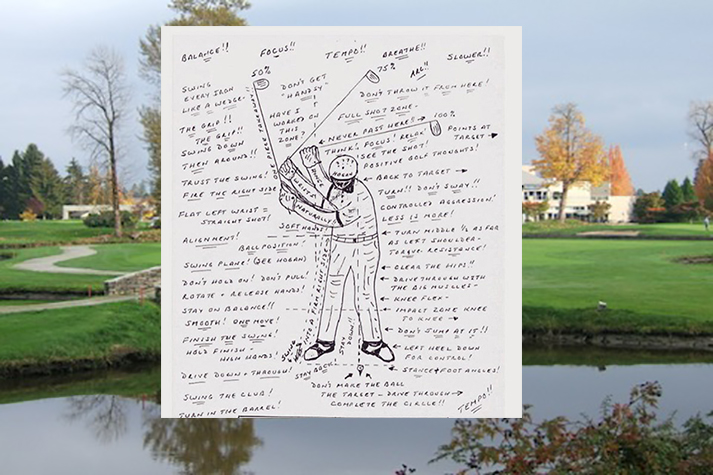The Key To Your Best Round Of Golf - Think About It
- Details
- Category: From The Fringe
- Published: 2017-08-10

by Ian Fabian (iG contributor)
There is no doubt in my mind that the key to your best round of golf ever is the “swing thought.”
We constantly hear that the game is far more mental than physical and therein lies the power of the swing thought. For those who may be new to the game let me endeavour to explain exactly how the swing thought works (or, in some cases, doesn’t work).
Anyone who’s become infatuated with the game likely has a tremendous pool of resources from which to compile a working, or… again, not working, library of swing thoughts.
This very web article that you’re now reading, the Golf Channel, lessons from a pro, advice from your friends and playing partners and even advice from strangers who’ve never seen you swing a golf club, all are potential sources from which to amass your arsenal of swing thoughts.
If you have managed to accumulate less than 300 swing thoughts throughout your golfing life so far, you require more input. However, please be forewarned that it’s extremely dangerous to use any more than 6 of these swing thoughts at the same time!
Let’s start with some of the basic rules as they apply to: The Swing Thought
- The swing thought(s) that you use on the driving range before your round are not necessarily going to work during the course of your round.
- A swing thought that appears to be working perfectly during the course of the round may suddenly and without apparent reason cause you to hit a shank.
- Once the aforementioned “shank” has occurred, it’s best to change swing thoughts immediately, which is one of the advantages of having multiple swing thoughts before every swing.
- Should you not have an extensive library of swing thoughts to choose from after the shank has taken place it’s completely permissible to accept advice from your playing partners as to what may or may not have caused the miscue in the first place. (Please feel free to ignore Rule #8 of the Rules of Golf, as such a traumatic experience removes any obligation to follow what has to be considered a foolish rule in the first place). You may then incorporate any of this advice into your next swing thought.
- Swing thoughts rarely, if ever, work from one round to the next. Should you find a swing thought or thoughts that work for a whole round be prepared to abandon it/them when you start your next round. This becomes more manageable the older you get as remembering anything at all becomes increasingly more difficult.
Feel free to share your swing thoughts with your playing partners and friends. You’ll find that this will greatly enhance your library as well as their own as they’ll generally be more than happy to supply you with numerous swing thoughts that have worked for them.
Sharing swing thoughts is a powerful tool when playing match play events. While it’s not permissible during the round to give or receive advice (see: pesky Rule of Golf #8) the mentioning to an opponent on either the driving range or the putting green of a particularly obscure and physically contradictory swing thought that has worked wonders for you prior to the match taking place is not only permitted but may have the effect of giving you somewhat of an advantage as your opponent attempts to incorporate it into his pre-shot routine.
Some may consider this poor sportsmanship, I prefer to think of it as golf’s version of “trash talking”. It’s been my personal experience that while instruction and swing thoughts from professional teachers can be far more helpful than those coming from other sources there are dangers inherent in these as well.
You and your instructor have to be “speaking the same language”. Now, you may think this is pretty obvious advice; don’t take lessons from a Croatian teacher if you don’t have a working knowledge of Croatian or he or she doesn’t have one of English.
Even if you both have the same first language, difficulties can arise in the terminology. I spent over a year trying to understand the phrase “hit through the ball”. The people who were telling me this knew exactly what they meant and I of course thought I was “hitting through the ball” and couldn’t understand why my 6-iron went higher than their sand wedges and went a whopping 120 yards if I really got ahold of one.
I did eventually figure it out, but it had to make sense in my mind not theirs, and I now hit my 6-iron farther than 120 yards.
Hopefully this has helped clear up the concept of “swing thoughts” for you and helped you to understand exactly how they can best be used to your advantage. The other alternative, of course, is to just stand up and hit the ball without thinking at all, but that is a far more difficult talent to master than one might imagine.
About the Writer:
Ian Fabian is a self-proclaimed golf addict and makes no apologies for it. He can be found most weekends carving out his legacy on his home golf course and is easily recognized by the cloud of swing thought bubbles following him around like the cloud of dust followed Pig Pen from Charles Schultz' famous Peanuts comic strip.



